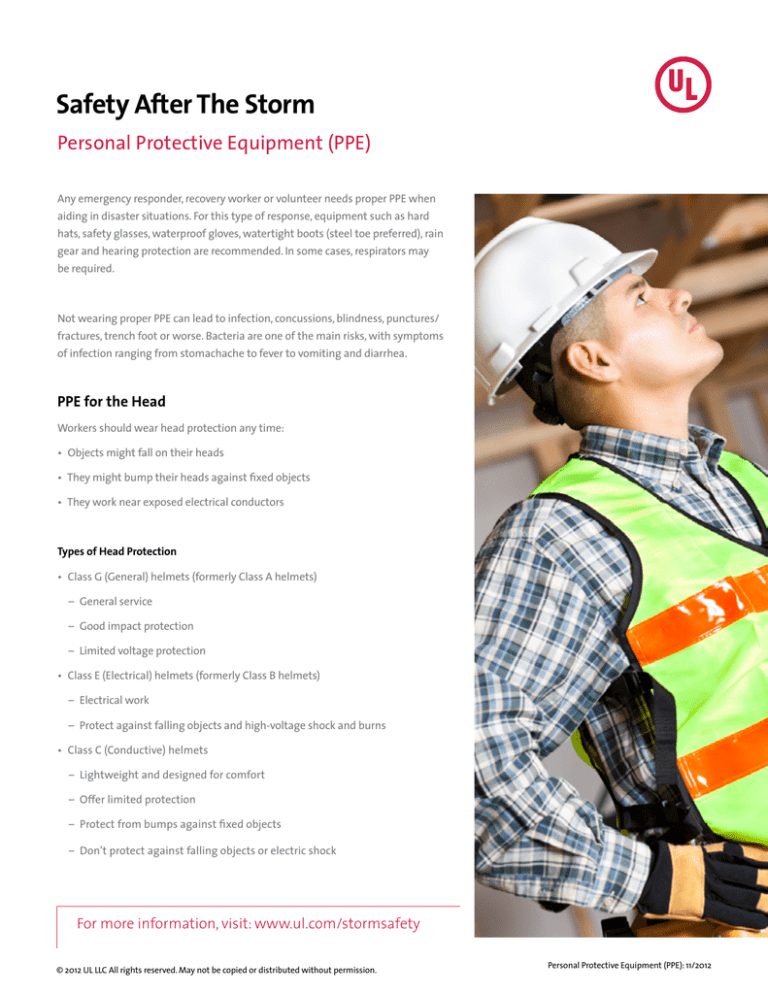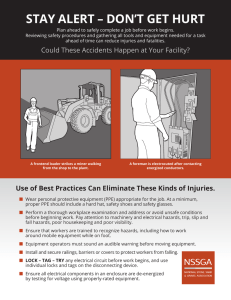
Safety After The Storm
Personal Protective Equipment (PPE)
Any emergency responder, recovery worker or volunteer needs proper PPE when
aiding in disaster situations. For this type of response, equipment such as hard
hats, safety glasses, waterproof gloves, watertight boots (steel toe preferred), rain
gear and hearing protection are recommended. In some cases, respirators may
be required.
Not wearing proper PPE can lead to infection, concussions, blindness, punctures/
fractures, trench foot or worse. Bacteria are one of the main risks, with symptoms
of infection ranging from stomachache to fever to vomiting and diarrhea.
PPE for the Head
Workers should wear head protection any time:
• Objects might fall on their heads
• They might bump their heads against fixed objects
• They work near exposed electrical conductors
Types of Head Protection
• Class G (General) helmets (formerly Class A helmets)
– General service
– Good impact protection
– Limited voltage protection
• Class E (Electrical) helmets (formerly Class B helmets)
– Electrical work
– Protect against falling objects and high-voltage shock and burns
• Class C (Conductive) helmets
– Lightweight and designed for comfort
– Offer limited protection
– Protect from bumps against fixed objects
– Don’t protect against falling objects or electric shock
For more information, visit: www.ul.com/stormsafety
© 2012 UL LLC All rights reserved. May not be copied or distributed without permission.
Personal Protective Equipment (PPE): 11/2012
Safety After The Storm
Personal Protective Equipment (PPE)
Inspection and Maintenance
• Paints/thinners may reduce physical protection or electrical resistance.
• Clean shells with detergent, and rinse with clear, hot water.
• Do NOT store hard hats in direct sunlight.
• Replace damaged helmets!
PPE for the Eyes and Face
Wear eye protection anytime you may be exposed to the hazards that typically cause eye and face injuries. Examples of these hazards include:
• Splashes of toxic or corrosive chemicals
• Hot liquids and molten metal
• Flying objects
• Fumes
• Gases and mists of toxic or corrosive chemicals
amounts of coverage for your eyes and face. Inspect eye and face
protection before use, and keep it clean and disinfected regularly
with soap and water.
• Aerosols of biological substances such as blood
• Intense light
PPE for the Hands and Arms
• Optical radiation
Wear hand and arm protection anytime you may be exposed to
Eye and face protection may include:
• Safety glasses • Face shields
• Impact-resistant glasses • Eyeglasses
the hazards that typically cause hand and arm injuries. Examples
of such hazards include:
• Objects with sharp edges and pinch points
• Objects that can cause puncture wounds
• Objects that can strike your hands and arms and break • Side shields • Welding shields
or fracture the bones
• Laser glasses or goggles • Goggles
• Corrosive or toxic chemicals
• Electrical sources
Choose the appropriate PPE for any given set of hazards,
keeping in mind that different types of PPE offer different
• Extremely cold or hot objects that can irritate or burn your arms or hands
For more information, visit: www.ul.com/stormsafety
© 2012 UL LLC All rights reserved. May not be copied or distributed without permission.
Personal Protective Equipment (PPE): 11/2012
Safety After The Storm
Personal Protective Equipment (PPE)
Glove and sleeve materials may include:
Body PPE may be made of the following materials:
• Metal mesh • Coated fabric
• Paper-like fiber • Rubber
• Insulating rubber • Canvas
• Treated wool and cotton • Plastics
• Chemical-resistant material • Cotton duck • Neoprene
• Fabric
• Liquid-resistant material • Leather
• Rubberized fabric • Leather
Choose gloves and sleeves made of the appropriate material.
Choose body PPE made of material that is appropriate for each
Inspect and maintain hand and arm protection before using
it. Always replace gloves and sleeves that are worn or torn.
Remember to store PPE in a clean and dry location.
PPE for the Body
Require your workers to wear body PPE anytime they may be
exposed to the hazards that typically cause body injuries.
These hazards may include:
• Intense heat
• Splashes of hot metals and other hot liquids
• Impacts or cuts from tools, machinery and materials
• Hazardous chemicals
• Blood and other potentially infectious materials
• Radiation
Your workers should wear body PPE that covers the body part
at risk. Examples of PPE for the body include:
hazard. Before your workers wear any kind of body protection, they
should check it for signs of wear such as rips, tears, scuffs or loss
of elasticity. If the body protection is damaged, do not allow your
workers to use it. Provide training on how to clean and disinfect
your body protection to prolong its life. Require your workers to
store their body PPE in a clean and dry location.
PPE for the Feet and Legs
Require your workers to wear foot and leg PPE anytime they may
be exposed to the hazards that typically cause foot or leg injuries.
These hazards may include:
• Sharp objects
• Heavy objects
• Electricity
• Extreme heat
• Extreme moisture
• Slippery surfaces
• Liquids such as acids, caustics and molten metal
• Vests • Coveralls
• Jackets • Aprons
Types of foot and leg PPE may include:
• Full-body suits
• Leggings • Metatarsal guards For more information, visit: www.ul.com/stormsafety
© 2012 UL LLC All rights reserved. May not be copied or distributed without permission.
Personal Protective Equipment (PPE): 11/2012
Safety After The Storm
Personal Protective Equipment (PPE)
• Safety shoes
• Toe guards
• Combination foot-and-shin guards
Non-disposable ear protection should be cleaned with soap
and water. Disposable and damaged ear protection should be
discarded. When your workers are not using ear PPE, they should
store it in a clean, cool, dry place.
• Electrically conductive shoes
• Electrical hazard/safety-toe shoes
• Foundry shoes
Respiratory Protection
Workers should wear respiratory protection anytime they may be
exposed to hazards that may damage their respiratory systems
Choose the appropriate foot protection for the hazards present in
your employees’ work environment. Before your workers put on
any foot protection, be sure they check it for signs of wear. Replace
or anytime they may be exposed to hazardous or toxic chemicals.
Always inform your workers about areas where these hazards
may be present.
damaged PPE. Train your workers to clean PPE according to the
manufacturer’s instructions and to store it in a clean and dry location.
Hearing Conservation Awareness
Any kind of loud noise is potentially hazardous.
• Continuous noise occurs when the interval between occurrences of the maximum noise level is one second or less.
• All noise that is not continuous is defined as impact noise.
Require your workers to wear hearing protection if they are
Workers must go through fit testing, medical clearance and
special training before using a respirator. They should inspect
their respirator before using it and have it repaired or replaced if
they find anything wrong with it. After using a respirator, workers
should clean and disinfect it. They need to store respirators in a
sealable bag away from:
• Dust • Extreme cold
• Sunlight • Moisture
• Damaging chemicals • Heat
exposed to noises of 85 decibels or higher for eight hours per day.
Hearing protection may include:
• Earplugs
• Earmuffs
• Preformed or molded earplugs
Help your employees choose the appropriate hearing protection
for the noise hazards present in their work environment, and
train them to inspect hearing protection before wearing it.
For more information, visit: www.ul.com/stormsafety
© 2012 UL LLC All rights reserved. May not be copied or distributed without permission.
Personal Protective Equipment (PPE): 11/2012
Safety After The Storm
Personal Protective Equipment (PPE)
Electrical Protective Devices
– Ingestion
Workers should always follow proper safety precautions and work
– Eye or skin contact
only on de-energized equipment and circuits that are equipped
• Performance of the PPE materials (and seams) in providing a with lock-out/tag-out devices. Permit only trained, qualified and
authorized employees to work on electrical equipment and circuits.
OSHA Standard 1910.137 covers electrical protective devices and
requirements. Electrical protective devices may include:
• Insulating blankets
• Matting
• Covers
• Line hose
• Gloves and sleeves made of rubber
barrier to hazards
– Material-specific limitations
– Breakthrough time
– Durability
– Work conditions, such as heat stress, that may affect the performance of the PPE
Choose the correct level of protection:
• Level A is appropriate when the greatest level of skin, respiratory and eye protection is required.
• Level B is appropriate when the highest level of respiratory The type and class of each electrical protective device will indicate
protection is necessary, but a lesser level of skin protection
the device’s limitations in terms of voltage protection and ozone
is needed.
resistance. Wearing the right protective equipment can mean
• Level C is appropriate when the concentration and type the difference between life and death. Workers need to make
sure electrical protective equipment is clean, safe and in reliable
condition. Repair or replace any equipment that is not safe to use.
Workers should store electrical PPE away from light, temperature
extremes, excessive humidity, ozone and other potentially
of airborne substances are known and the criteria for using air-purifying respirators are met.
• Level D is a work uniform affording minimal protection and should be used only for nuisance contamination.
damaging substances and conditions.
Safety Precautions to Be Considered
Levels of Protection and Protective Gear
• Use double gloving with waterproof gloves under work gloves.
When you select PPE, consider the:
• Boots and rain gear can be used to lower skin exposures.
• Hazards or suspected hazards that will be present
• Be aware of site-specific information for the work environment.
• Potential routes of exposure
• Avoid working alone.
– Inhalation
• Do not stay in wet clothing or PPE for extended periods due to – Skin absorption
risk of dermal irritation.
For more information, visit: www.ul.com/stormsafety
© 2012 UL LLC All rights reserved. May not be copied or distributed without permission.
Personal Protective Equipment (PPE): 11/2012
Safety After The Storm
Personal Protective Equipment (PPE)
• Hands and exposed areas should be cleaned regularly.
• Respiratory protection could be needed as conditions dry out.
Resources
http://www.cdc.gov/niosh/topics/emres/flood.html
http://www.cdc.gov/niosh/topics/emres/pre-workers.html#1
About UL
UL is a premier global independent safety science company
with more than 117 years of history. Employing more than 9,000
professionals with customers in over 100 countries, UL has five
distinct business units – Product Safety, Environment, Life &
Health, Knowledge Services and Verification Services – to meet
the expanding needs of our customers and to deliver on our
public safety mission. Additional information about UL may be
found at www.UL.com.
For more information, visit: www.ul.com/stormsafety
© 2012 UL LLC All rights reserved. May not be copied or distributed without permission.
Personal Protective Equipment (PPE): 11/2012

